Cast iron skillets are versatile, durable, and often considered one of the best kitchen investments. They’re great for searing steaks and roasting vegetables. And while you might think that you’d need to clean them with dish soap and water, a quick wipe-down with a paper towel is usually enough to keep them looking good.
But what about a glass-top stove? Do cast iron pans work well on a glass electric stovetop? Is there anything special you need to know? Let’s take a look.
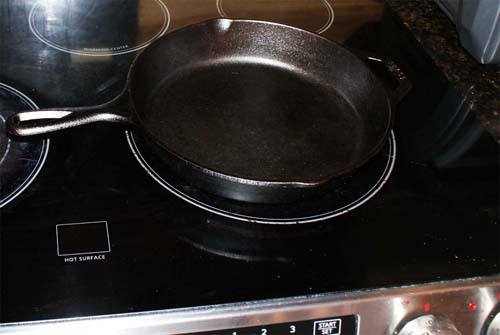
This article will cover the following subjects:
How can you prevent your glass top stove from getting damaged when cooking with cast iron?
The first thing you need to know is that cast iron pans were not created for glass stoves. They were initially made for use on campfires and then on traditional gas stoves with burners raised off the stove’s surface. Electric ranges with smooth tops require special care and maintenance to prevent them from being damaged. Some cast-iron cookware manufacturers warn against damaging the glass surface or shattering it. For example:
- Lodges says that is safe to use it’s cast iron skillets on glass-top stoves but without sliding them.
- Calphalon says that it’s preseasoned cast iron cookware is compatible with glass tops stoves.
Stove manufacturers also have some special care recommendations. For example:
- The GE electric smothtop range owners manual page 15 says that enameled cast iron is recommended but non-enameled can scratch the glass.
- Whirlpool glass top range owners manual page 8 says that this cookware ough edges or burrs may scratch the cooktop.
So, back to the question: can you use cast iron on a glass top stove? The answer is yes, but you must be careful. You need to take some special steps to protect your appliance.
But just because you have a very smooth, fragile glass cooktop doesn’t mean you must stop using your cast iron pans. Be cautious when using your heavy iron cookware, and you won’t experience any problems.
Here are some great tips for enjoying cooking with cast iron pots and pans on your electric glass top range without worrying about damaging it.
9 Tips to Safely Use Cast Iron Cookware On a Glass Stovetop
Tip 1 – Replace Old Damaged Pots and Pans
Cast iron cookware is made of a durable metal but develops rough edges and bumps on the bottom over periods of time. These imperfections can damage the surface. Older cast iron skillets usually are not as smooth and sleek as newer models. If you notice any damage, it may be time to upgrade to a more recent set.
Tip 2 – Beware of the Weight; This is Heavy Cookware
Avoid Dropping Your Pans and Pots
It would be best if you always keep an eye on what you’re doing when using cast iron. Keep your hands away from the handle when cooking. If you accidentally touch it, you’ll instinctively pull your hand back. This could lead to dropping the pan and shattering the glass.
Weight comparison: stainless steel, aluminum, and carbon steel skillets
Cast iron is a heavy metal, much weightier than stainless steel or hard anodized aluminum. I weighted my 10′ pans to be able to show you some examples. Here are the results.
- My cast iron skillet weighs roughly 5.1 pounds.
- The stainless steel pan weights 3.7 pounds.
- The carbon steel skillet is close to 3.5 pounds.
- And the hard anodized aluminum skillet weighs almost 3 pounds.
My test shows that cast iron skillets are 70% heavier than hard anodized aluminum, 38% heavier than stainless steel, and 46% heavier that carbon steel. Some brands may have different weights than the ones I tested, but the dissimilarities are likely minimal.
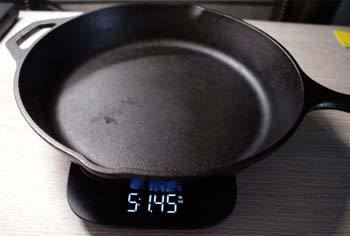
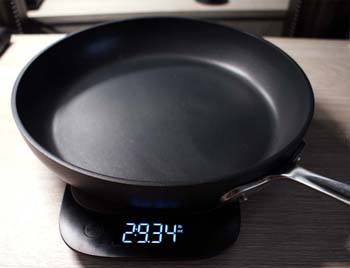
As you can see from the examples above, cast iron is heavy, so when you’re using it, be careful not to drop it. Use your two hands when lifting the skillet.
Remember, glass surfaces are fragile. Dropping your heavy pan increases the risk of breaking the electric stove glass top. Please put extra care when maneuvering your skillets.
Don’t slide or drag your skillet on the surface.
Dragging, sliding, or shuffling your iron cookware is the most common way to damage your glass top. It happens way too often. You will almost certainly scratch the cooktop surface if you drag a pan on an induction, or electric glass stovetop. Try to avoid doing it at all costs!
When cooking with cast iron cookware, place it firmly on the stove surface. You will almost certainly scratch the surface if you drag a pan on a glass or ceramic stovetop. Please do not move it around while cooking, as you will increase the chances of scratching the surface.
Tip 3 – Use a Silicone Hot Handle Holder
Cast iron can get very hot and takes time to cool down. It’ll be much easier to manage your iron to prevent damage if you have the right tools. Silicone handles holders and assists handles make it easy to pick up hot pans and pots while protecting your hands from burning. When I cook with my cast iron, I use the Lodge silicon handles shown in this image, so I don’t get burned and drop the pans by accident. I highly recommend getting these handy helpers (any brand you like).
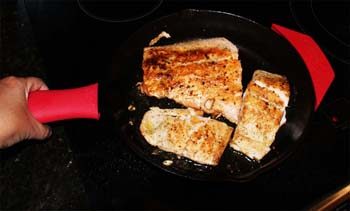
Tip 4 – Get a Cast Iron Heat Diffuser
You may want to consider buying a heat diffuser to get additional protection for your stove when cooking with cast iron.
A heat diffuser (also called a “skillet guard”) is a thin piece of metal that comes in several sizes and metallic materials. These kitchen tools go between your skillet and the burner and help distribute the heat evenly across the bottom of the skillet.
You can also use them to avoid damaging the surface of the glass stove. In addition to their primary heat distribution function, these diffusers are sturdy and can protect your stovetop and your skillet simultaneously. If you have a few dollars to invest, you may want to try them. A heat diffuser can considerably improve your cooking experience.
Tip 5 – Wash Your Cookware With Extreme Care – Get Rid of Food Residues
Leftover food or oil residue on the base of the pan can scratch your range’s smooth surface. In addition, the built-up carbon from heat can stain the surface.
To avoid this, remove the pan from the heat after using it and adequately clean the bottom of your cast iron cookware with warm water. Cleaning the bottom of your pan is easy if you have silicon scrapers like the ones shown in this image.
Avoid using steel wool sponges or abrasive cleaners to keep the seasoning healthy.
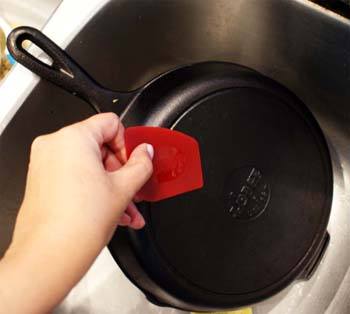
After scraping, use dish soap and hot water to get rid of all the food or oil residue. Then dry the pan completely (better with paper towels), and apply a light coat of oil to maintain the seasoning.
Tip 6 – Before Use, Ensure That Your Glass Cooktop is Clean
If you clean the stovetop before you cook, there won’t be any burnt food, black residue, or anything else smearing the surface. Small food bits or small pieces of salt can cause severe damage, including scratches, under the weight and pressure of the cast iron on glass. So, I highly recommend keeping your appliance clean to avoid these risks
Tip 7 – Bottoms of Cast Iron Cookware Must be Smooth
Rough surfaces on the bottom of your pans and pots present a high risk of damage to your smooth and fragile glass. Here are two essential things to pay attention to:
Choose pre-seasoned or enameled cast iron
Ebameled cast iron is an excellent material for glass top cooktops because it doesn’t scratch like other materials. The porcelain enamel coating creates a nonstick surface and smooth bottom.
If cookware with enamel coating is not your preference, an uncoated pre-seasoned cast iron pot or pan can be a great alternative. The seasoning creates an exterior finish that is smooth, has a flat surface, and is ready for use on a glass stovetop.
Beware of brand logos
Looking at the bottom of cast iron pans, you’ll notice that most of them have the brand’s logo stamped on the bottom. These logos usually create an uneven surface or small edges that have the potential to scratch your range.
For example, look at this image of the bottom of my Lodge pan. Lodge is a company that has been making these skillets for over 100 years, so they know better. They stamp the brand with care, indented on the mold, so their cookware has flat bottoms.
Finding cast iron cookware without brands and flat surfaces is not an easy task. Still, you can look for companies that place their brands carefully, so the bottoms of the skillets don’t have dangerous edges.
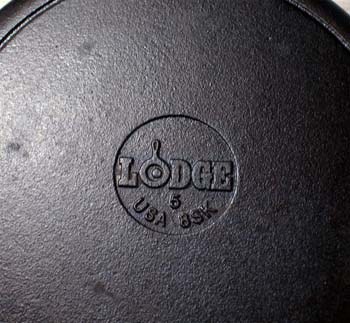
Tip 8 – Size Matters on Electric Stoves
Pay close attention to the size of the burners on electric stoves. Avoid placing your cookware on burners that are over one inch larger than the size of your pan. If the heating elements of the electric cooktop cover a much larger surface area than the pan, you might burn your hands when cooking. Your reaction could drag or drop the pan, which would cause damage to the stove.
Tip 9 – Avoid Suddenly Placing Hot Cookware on Glass Top Stoves
Cast iron pans have high heat retention properties. They take some time to heat up, but once heated, they keep their heat for a long time after you turn off the power.
Contrarily, glass is a poor thermal conductor. It heats up and then cools down very quickly.
Why does this introduction matter? Because high heat and excessive thermal variations can cause the glass to shatter or break.
If you are searing a steak on the cooktop and then placing it in the oven to finish, during that cooking time, your pan will get even hotter but the glass will cool down fast. If you take that extremely hot pan off the oven and place it back on the stove right away, that rapid temperature change may cause stress fractures in the glass, eventually cracking.
To avoid this hazard, place the pan on a pot holder or a cooling rack instead.
About Induction Cooktops With Glass Tops
Induction stoves are electric stoves that use magnetic fields to trigger and transfer an electrical current into the cookware placed on the surface. You can only use cookware made of ferrous metals for cooking on these stoves. Cast iron perfectly works on an induction cooktop because it is a magnetically conductive material.
Induction stoves have glass tops, so most of the tips detailed above also work for them.
We hope you've found this guide helpful and can take advantage of all the tips we mentioned.
If, after reading this article, it seems that cast iron isn’t for you, here are other types of cookware materials you may want to consider to improve your cooking experience:
